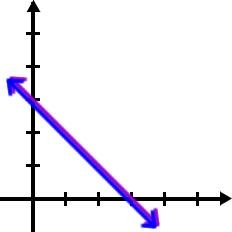The other freaky thing that can happen is that the two lines can be lying right on top of each other -- they are the same line.
Let's graph these two lines:
|  |
So, what the heck does this mean for our answer? Every single
(x, y) point that appears in one line appears in the other. So, everyx and y combination that works in one equation, works in the other equation. And how many points are in a line? That's right, baby, there's an infinite number of them! So how many points that work in one line work in the other? An infinite number.
You should write something like this for your answer:
These are the same line, so there are |
How is this little critter going to announce itself to you?
When you're solving by elimination or substitution... you'll be going along... and you'll get this:
![]()
A true statement, but not very helpful unless you know what you're doing -- and you do!
TRY IT:
Solve by either elimination or substitution. Then, check your answer by graphing:
![]()
![]()